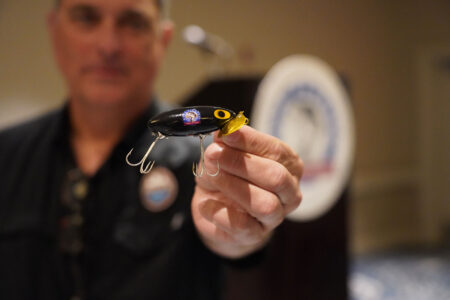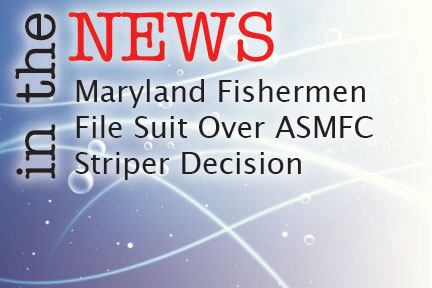On August 5, 2020, The Atlantic States Marine Fisheries Commission (ASMFC) and its Atlantic Menhaden Management Board (Board) approved the use of ecological reference points (ERPs) in the management of Atlantic menhaden. The unanimous ASMFC decision will ensure that the needs of predator species are considered when fisheries managers adopt certain measures impacting menhaden in the future.
Atlantic striped bass was the focal species for the ERP definitions because it was the most sensitive predator fish species to Atlantic menhaden harvest in the model, so an ERP target and threshold that sustained striped bass would likely provide sufficient forage for other predators under current ecosystem conditions.
“Today’s decision is a critical step towards acknowledging that forage fish like menhaden are ecologically important to recreationally important species like striped bass and bluefish,” said Mike Leonard, vice president of Government Affairs for the American Sportfishing Association (ASA). “A healthy Atlantic menhaden stock, and quotas that account for the needs of predators, is the science-based management we look for to help support a healthy ecosystem and the sportfishing opportunities it provides.”
According to a recent scientific study cited by ASA, menhaden reduction fishing contributes to a nearly 30% decline in striped bass numbers, whereas the striped bass fishing industry contributes $7.8 billion in gross domestic product (GDP) to the Atlantic Coastal economy.
“The Board took another important step in managing Atlantic menhaden in a broader ecosystem context,” stated Board Chair Spud Woodward of Georgia. “It’s the culmination of more than a decade of effort by state, federal, and academic scientists to develop ERPs that reflect menhaden’s role as a key food source for several fish species. These ERPs are not a silver bullet to resolve all our fisheries management issues, and the models on which they are based will continue to evolve. However, the use of ERPs for menhaden management will enhance the success of predator management by providing a more abundant forage base for rebuilding predator fish populations. It is important for us to keep those rebuilding efforts on track through the use of proven management tools such as controls on fishing mortality.”
In February and May, the Board tasked the ERP Work Group with additional analyses to explore the ERPs sensitivity to a range of ecosystem scenarios (different assumptions about fishing mortality for other key predator and prey species) and Atlantic herring biomass. These analyses suggested the original scenario (ERP target and threshold outlined below) most closely approximates short-term conditions for the ecosystem. As a result, the ERP Work Group recommended using the original scenario ERPs presented in the assessment report.
Moving forward, the ERPs for Atlantic menhaden are:
ERP target: the maximum fishing mortality rate (F) on Atlantic menhaden that sustains Atlantic striped bass at their biomass target when striped bass are fished at their F target.
ERP threshold: the maximum F on Atlantic menhaden that keeps Atlantic striped bass at their biomass threshold when striped bass are fished at their F target.
In addition to adopting ERPs, the Board discussed setting fishery specifications for 2021-2022. In 2017, the Board set the total allowable catch (TAC) at 216,000 metric tons for 2018-2019, and then maintained that TAC for 2020 with the expectation that it would be set in future years using ERPs. With the adoption of ERPs, the Board tasked the Atlantic Menhaden Technical Committee to run a projection analysis to provide a variety of TAC scenarios and their risk of exceeding the ERP F target to compare in setting specifications for 2021-2022. The Board will review the projection analysis at the Annual Meeting in October and then determine a TAC for 2021-2022. As stated in Amendment 3, if a TAC is not set at the Annual Meeting, the TAC from the previous year will be maintained.
“Recreational boaters and anglers stand behind science-backed conservation efforts to maintain the health of our nation’s fisheries,” said Adam Fortier-Brown, Government Relations manager for the Marine Retailers Association of the Americas. “This is why our community has come out so strongly in support of the approved Atlantic menhaden management plan, which would support the whole ecosystem and begin the process of bringing back populations of prized fish like striped bass, bluefish and weakfish.”
Menhaden, aka bunker or pogies, Atlantic menhaden – aka bunker or pogies – have supported one of the largest fisheries in the U.S. since colonial times, with landings going into fish meal, fish oil, and bait for other fisheries. However, Atlantic menhaden are also a food source for wide range of species including Atlantic striped bass, bluefish, sea birds, and marine mammals. Many of these predators support valuable commercial and recreational fisheries or ecotourism industries.
According to the ASMFC, the single species reference points that have been used to manage Atlantic menhaden do not take into account their role as a forage fish. Therefore, ERPs are needed to ensure that there are enough menhaden not just for human use but also to sustain its predators. This oily bait fish has now become the first fishery on the east coast to shift to an ecosystem management approach.
The Atlantic menhaden commercial fishery consists of a reduction fishery (named because it “reduces” the whole fish into fish meal and fish oil) and a bait fishery that supplies bait and tackle shops and commercial fishermen with its bait. The reduction fishery first began in New England during the early 1800s and spread south after the Civil War. The reduction fishery grew with the advent of purse seines in the mid-1800s and reached peak landings in 1956 at 712,100 metric tons when there were more than 20 menhaden reduction factories in operation from Florida to Maine. The Atlantic menhaden stock continued a downward trend for the next 50 years; by 2006, there was only one remaining reduction plant in operation on the Atlantic coast processing menhaden into fishmeal and oil, the Omega Protein plant in Reedville, VA which is still in operation today.
Following ASMFC’s decision, officials at Omega Protein said they will “work with the commission and its staff on further developing the ERP (ecological reference points) model and identifying future harvest levels for the fishery.”
In late 2019, U.S. Secretary of Commerce Wilbur Ross officially found the state of Virginia out of compliance after Omega Protein willfully violated an ASMFC mandated fishing cap on menhaden in the Chesapeake Bay.
On May 14, ASMFC notified the Secretary of Commerce that the Commonwealth of Virginia had come into compliance by setting the state cap at approximately 36,000 metric tons, nearly 15,000 metric tons below the required cap to reflect overages that occurred in 2019. The Virginia Marine Resources Commission, which now has regulatory authority for menhaden management in state waters, will set the cap at 51,000 metric tons in 2021 as long as catch is below the cap set in 2020.





